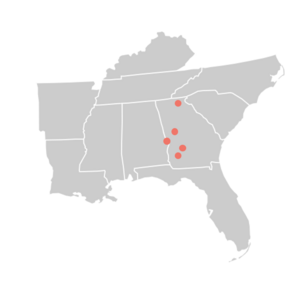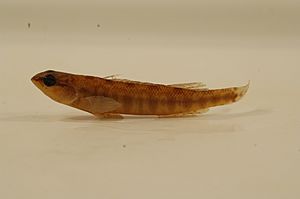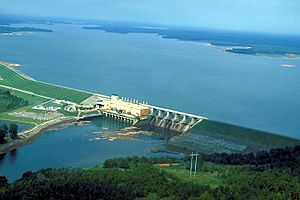Halloween darter facts for kids
Quick facts for kids Halloween darter |
|
|---|---|
| Conservation status | |
| Scientific classification | |
 |
The Halloween darter (Percina crypta) is a small freshwater fish. It lives in North America. You can find it in Georgia and Alabama. It lives in rivers that flow into the Apalachicola River. These include the Flint River and the Chattahoochee River.
This fish likes shallow, fast-moving parts of rivers. It prefers areas with gravel at the bottom. Scientists first described it in 2008. Before that, people thought it was the same as the blackbanded darter (P. nigrofasciata).
Halloween darters have different colors. They are usually dark on top. Some have faint saddle-like stripes. Males have orange and dark stripes on their sides. Females have dark stripes and a yellowish-green belly. Males can grow up to 101 millimeters (about 4 inches) long. Females are a bit smaller. During breeding season, both males and females get bright orange stripes on their first dorsal fin.
The Halloween darter lives in a small area. Its populations are spread out. The biggest danger to this fish is that its home is getting unhealthy. Because of this, it is listed as a "vulnerable species". This means it could become endangered if things do not change. It is also protected in Georgia and Alabama.
Contents
Discovering the Halloween Darter
Scientists officially named the Halloween darter in 2008. Mary C. Freeman, Byron J. Freeman, and Noel M. Burkhead described it. Byron J. Freeman first collected a sample in 1994. This sample was from the Chattahoochee River in Georgia.
The scientific name crypta comes from a Greek word. It means "hidden" or "concealed." This name was chosen because the fish was "hidden" for a long time. It looked so much like the blackbanded darter. People thought the blackbanded darter was the only one of its kind in the Apalachicola River area.
The common name "Halloween darter" was chosen for a fun reason. The fish has orange and black colors when it is ready to breed. These are the colors of the holiday Halloween.
Family Tree of the Darter
Scientists study DNA to understand how species are related. They found that the Halloween darter and blackbanded darter are part of a group. This group is called a subgenus named Hadropterus. It includes nine other darter species.
These other darters are:
- The Guadalupe darter (P. apristis)
- The goldline darter (P. aurolineata)
- The dusky darter (P. sciera)
- The bronze darter (P. palmaris)
- The bridled darter (P. kusha)
- The muscadine darter (P. smithvanizi)
- The Bankhead darter (P. sipsi)
- The freckled darter (P. lenticula)
- Westfall's darter (P. westfalli)
It is hard to tell the exact family connections within this group. A study in 2018 found that Halloween darters and Westfall's darters in some rivers are very similar. Some people think Westfall's darter might even be a type of blackbanded darter.
What Does the Halloween Darter Look Like?

Halloween darters have bodies that are round or slightly tapering. Males are longer than females. Males can be up to 101 millimeters (about 4 inches) long. Females can be up to 85 millimeters (about 3.3 inches) long.
Their colors are different for males and females.
Male Halloween Darters
Males have heads that are dark bluish-gray to black. They have shiny green or gold spots on their cheeks and gill covers. Their eyes are dark. They have a black stripe in front of their eyes. Their chin and lower jaw are bluish-black.
Their sides are pale orange with blackish stripes. These stripes might have a hint of shiny green. Their backs are either black or amber/orange with black saddle-like markings.
Female Halloween Darters
Females have dark olive-black tops of their heads. Their snouts are similar but lighter. Their cheeks and gill covers can be different colors. They might be medium olive-black with yellow crescent shapes. Or they might have small yellow dots or blotches.
Like males, they have shiny green or gold spots. These spots are mostly on their gill covers or shoulder bones. Females' eyes are dark. Their jaws can be olive-black to pale yellow. Their bellies are pale yellowish-green and sometimes pink. They also have olive-black stripes on their sides and dark saddle-like markings on their backs. The color between these saddles is amber to pale yellow.
How to Tell Them Apart
You can tell the Halloween darter from other similar fish by these features:
- The membranes under their gills are slightly connected.
- The bone near their cheek and gill membrane is smooth, not jagged.
- They usually have seven saddle-shaped color bands on their back.
- During breeding season, both males and females have yellowish-orange or orange bands near the edge of their first dorsal fins.
Where Do Halloween Darters Live?
The Halloween darter lives only in the Apalachicola River watershed. This watershed is formed by two rivers coming together: the Flint River and the Chattahoochee River.
In the Flint River area, you can find this fish in many smaller streams. These include Potato Creek, Lazer Creek, Muckalee Creek, and Ichawaynochaway Creek.
In the Chattahoochee River area, it lives above Lake Lanier in Georgia. It is found in the Chattahoochee River itself, the Chestatee River, and Sautee Creek. It also lives in Uchee Creek in Alabama.
This fish usually lives in fast-flowing parts of small and medium rivers. It likes bottoms made of gravel, cobble, or rock. Often, it lives where a plant called hornleaf riverweed grows.
Halloween Darter Life and Habits

The Halloween darter is an insectivore. This means it eats insects. It eats different kinds of water insects. These include mayfly nymphs and larvae of midges, black flies, and caddisflies.
Reproduction and Life Cycle
Halloween darters reproduce in the spring. They usually spawn (lay eggs) in April and May. They likely lay eggs in fast-flowing areas of the river. Females lay between 23 and 335 eggs. Larger females lay more eggs. The eggs are about 1.5 millimeters (0.06 inches) wide.
The young fish hatch in June. By October, they grow to more than half the size of an adult. They can start having their own babies when they are one year old. Most Halloween darters probably live for less than three years.
Helping Mussels Grow
The Halloween darter is important for some types of freshwater mussels. It is a host for the gulf moccasinshell mussel. This mussel is an endangered species. The mussel releases tiny young called glochidia. These glochidia attach to the gills of fish like the Halloween darter. They stay there and grow into young mussels.
Scientists tested 24 types of fish. Only the Halloween darter and three other darter species helped the gulf moccasinshell larvae grow successfully. The Halloween darter also helps the larvae of the purple bankclimber mussel grow. About 34% of these mussel larvae successfully grow on the Halloween darter.
Protecting the Halloween Darter

The Halloween darter has several separate groups of fish. The total area where it lives is less than 2,000 square kilometers (about 770 square miles). The biggest danger to this fish is that its home is becoming unhealthy.
This fish likes deep, fast-flowing water. But dams built on rivers change how the water flows. They also cause more dirt and mud to settle. In Georgia, the four main groups of Halloween darters are separated by man-made lakes. If one group dies out, other groups cannot naturally move in to replace them.
Also, more cities and towns mean more water is taken from rivers. And waste treatment can affect water quality. Because of these problems, the International Union for the Conservation of Nature says this fish is "vulnerable". This means it is at risk of becoming endangered.
In 2010, some environmental groups asked the United States Fish and Wildlife Service to protect the Halloween darter. They wanted it listed under the Endangered Species Act of 1973. They said its home was being destroyed. They also said there were not enough rules to protect it. As of 2019, it is still being reviewed for this protection.
In Georgia, the Halloween darter is listed as a threatened species. In Alabama, it is protected by a special rule. This rule makes it against the law to catch, trade, or kill the fish without a special permit.


